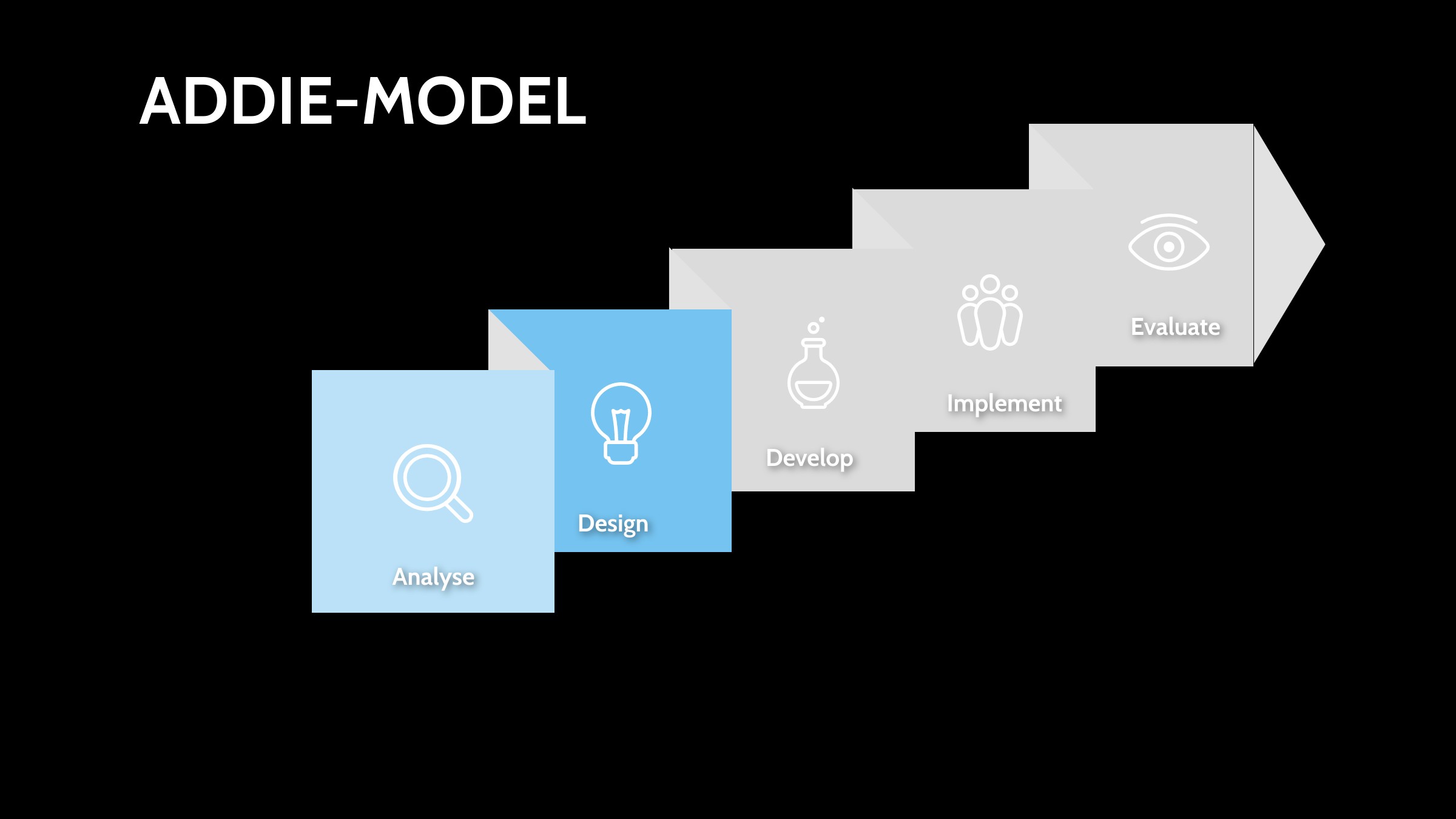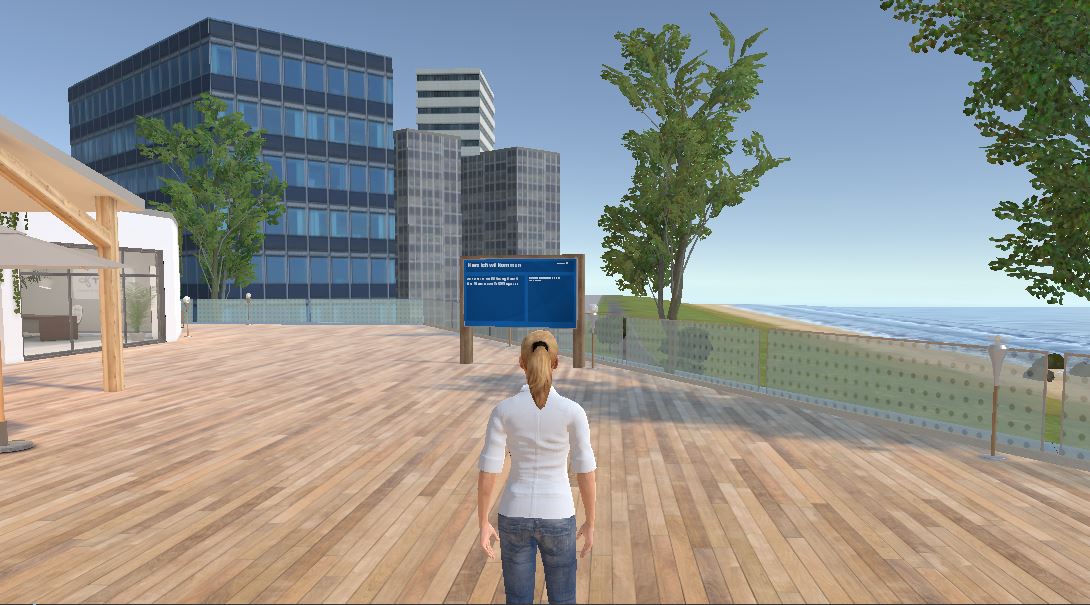Phase 2 - Design Your Big Picture

Introduction
During this design phase, based on your previous analysis, you will be structuring your contents within the framework of a draft concept. Both for the individual learning units and the course as a whole, you will be defining the following: Title, Learning Objectives, Resources, Activities and Formative and Summative Assessment Opportunities.
A promenade through virtual spaces
Before you start designing your online course, we recommend that you familiarise yourself with virtual environments. In contrast to conventional rooms you are not restricted by physical restrictions, instead, you need to be prepared to work around technical restrictions that users might have and their ability to understand the dynamics of the space.
In the picture you see the avatar of one of our future.film.education instructional designers on the Tricat platform. When planning online seminars, fundamental considerations include which objects you will use and where to place them, the learner's role and the atmosphere that a room is intended to evoke. The most significant difference between real and virtual space is acceleration, which extends into the world we experience physically. Long distances can be covered in seconds, affecting our perception of tme. You can affect the learner's mood or attitude through your set up of the learning space, as soon as they enter, which in turn will affect their awareness and attention, according to what they encounter.
Given that you are able to attract learners from all over the world, in all walks of life, a stable internet connection for all students is an unrealistic expectation. Key factors for network performance might include home-office vs. institutional infrastructure, national network structures, costs, rural areas, or power outages, affecting accessibility to the learning space. Other considerations are age, gender, socioeconomics or professional orientation, which influence an affinity with digital devices. It is necessary to consider time zones as well as your choice of dates (public holidays, religious festivals, weekend structures) when planning your course..
A virtual space is an arrangement of landmarks that has to be constructed through technical provision (platform, virtual seminar room, messenger, etc.) and interaction. Rooms are defined by the interrelations and interactions between users and objects. The interaction of users breathes life into spaces. The users cannot be sure of the "real" presence of others when they are online, because online students can create anonymous identities when they develop their avatars or username. This can all have an impact on the dynamics of the learning space.
Thus, it is important for virtual spaces to transmit emotions through the media architecture (technically, socially, in terms of content). Like traditional educational spaces, virtual spaces may also perceived to be as places where people can stay and experience things. Virtual spaces should allow "experiences", which matches the intention of film teaching in the meaning of observing and collecting. Learning arrangements should consider not only pedagogical-didactic dimensions, but also aspects of usability (user interface design). An awareness of aspects related to media socialisation in media-mediated learning is a prerequisite to overcome (technical) barriers and to ensure mindful supervision of learners, which is critical for success especially in e-learning. For an overview of virtual meeting rooms, visit our technology toolkit.
What does online learning mean for you?
Bevor starting with your design process consider what online learning means for you. Do you have a digital mindset?
By online learning we mean those forms of knowledge transfer and competence development in which digital media is used for the presentation and provision of learning materials and/or to support communication. Synonymous terms here are also:
Multimedia learning, distance learning, tele-learning, online learning, blended learning (online and face-to-face learning), computer-based course.
There is no uniform definition of online teaching. In all these definitions the "e", the technology, is in the foreground. For our understanding, the technology should be supportive and run reliably. In our opinion, learning success still depends on the teacher and the willingness of the students to want to learn or to be able to apply what they have learned. The same opinion is shared by the authors Ko and Rosse, who demonstrate this point excellently in this article Preparing to teach online:
“Techies don’t necessarily make the best online instructors. An interest in pedagogy should come first, technology second.”
Technology itself must be seen as a tool that enables learning of the course content. It is essential to make the technology as invisible as possible. So, discover more about a new emerging pedagogy. We can use the power of psychological principles to build effective e-learning courses. Online learning is not “slapping classroom content online”.
The page Introduction to Design, Develop, and Implement Effective Online Instruction gives insights into online pedagogy. An online teacher needs to use technology to maximize on the impact of their course content. By taking advantage of technology, with learning effectiveness in mind you can deliver a more sustainable learning experience.
Bill Pelz, Professor of Psychology names three principles of effective online pedagogy:
- Principle 1: Let the students do (most of) the work. The more time students spend engaged with the content, the more they will learn.
- Principle 2: Interactivity is the heart and soul of effective asynchronous learning.
- Principle 3: Strive for presence: social, cognitive, and teaching presence.
For this reason, keep your didactic approach in mind when planning your course. Ideally, you should think about your course from the end and start with the output. Every decision that you make should be based on whether it will help get your student's closer to the learning goals. Technology is just a means to an end. To go beyond the analysis phase of the ADDIE model in defining learning objectives, we recommend that you have a closer look at the concept of constructive alignment. The concept of constructive alignment describes the possibility of teaching from a single mould.
How you can use constructive alignment to design your online course
Constructive alignment helps designing online courses and choosing course activities and materials. In addition, it can be used to explain the relationship between course activities and assessment. It ensures that the intended learning outcomes for a program are effective, clear and purposeful, and that learning activities and assessment tasks are aligned with these outcomes. This video Course Design: constructive alignment of University of Groningen gives a brief overview:
The term “constructive alignment" was introduced by John Biggs. John Biggs is an Australian educational psychologist who developed the concept of Constructive Alignment and the SOLO taxonomy for assessing learning objectives. If you are interested in exploring the model, read his explanation on his webpage.
"In constructive alignment,we start with the outcomes we intend students to learn, and align teaching and assessment to those outcomes. The outcome statements contain a learning activity, a verb, that students need to perform to best achieve the outcome, such as “apply expectancy-value theory of motivation”, or “explain the concept of … “.(John Biggs)
Click on this link or on the picture to reach out an inspiring presentation about constructive alignment: You might be wondering how this will have a positive impact on your course. By applying constructive alignment, your teaching gains coherence and transparency. Teachers sometimes worry about what they want to teach. Students, however, are less concerned about the content than they are about what is being tested. With constructive alignment, teaching objectives, teaching-learning activities and examinations are intertwined in such a way that basically everything is strictly aligned with the learning objectives and there is no longer any difference between the teachers' and the students' perspectives.
You might be wondering how this will have a positive impact on your course. By applying constructive alignment, your teaching gains coherence and transparency. Teachers sometimes worry about what they want to teach. Students, however, are less concerned about the content than they are about what is being tested. With constructive alignment, teaching objectives, teaching-learning activities and examinations are intertwined in such a way that basically everything is strictly aligned with the learning objectives and there is no longer any difference between the teachers' and the students' perspectives.
To get a practical insight we recommend this video series Teaching Teaching & Understanding Understanding which is a 19-minute award-winning short-film about teaching at university and higher-level educational institutions. It is based on the "Constructive Alignment" theory developed by John Biggs. This provides you with the basics for understanding what a teacher needs to do to make sure all types of students learn what the teacher intends.
How you can organise your materials in a graphical format
So by now you will have gathered all of the materials for your course. How can you make it simple to learn and memorable for your students? Remember that you need to keep your students' attention in front of the screen. one approach is to use graphic organisers, especially for film teachers in a visual environment. Graphic organizers arrange information and ideas in a way that makes them easy to understand and memorize. Through the integration of text and images, graphic organizers demonstrate connections between concepts, ideas and facts. They are easy to create and simplify information. The benefits are:
- The way that you plan exactly how you want to visualize and present comprehensive or complex concepts or ideas by breaking them down into smaller, simpler parts.
- Opportunity for students to contribute and participate actively in the learning process by creating their own graphic organizers.
- Development of cognitive skills such as brainstorming, critical and creative thinking, categorizing and prioritizing content, reflection, etc.
- Recalling existing knowledge.
- Support for self-learning. Using graphic organizers to take notes, analyze, study, etc. makes it much easier for students to engage with a lesson.
The page The Ultimate List of Graphic Organizers for Teachers and Students shows you 19 different ways to organize the teaching material in a more graphic form and describes the necessary tools for it. We found it ideal for teachers who want to benefit from organizing their work and their classes differently.
How you can design a flipped classroom
As digital techers, we cannot (yet) clone ourselves with avatars and be everywhere live at the same time. So what can we do to work effectively?
We will now present a concept that literally turns your training world upside down: The flipped classroom concept.
???
This is a form of teaching in which you invest more time in creating materials beforehand than later in the training. Afterwards, your students are empowered to learn and organise themselves more independently. We would like to share with you one of our own online teaching experiences to demonstrate how a flipped classroom works in practice:
One of our team members implemented a flipped classroom concept for distance learning students using blended learning (online and onsite). The course was offered as a face-to-face format in addition to an online class. For the online course, the trainer wrote an 120-page script for six 6 lessons as basic literature. For each lesson, there was a 10-minute vodcast in each of which she explained the individual themes. This material was also used as the basis for the flipped classroom. In total, more than 4,500 online students attended this online course over a period of seven years. The flipped classroom was offered in different study centres and was attended by an average of 10-20 onside students. The students were provided with a publication to accompany the course with more than 100 questions categorised according to their level - easy/medium/difficult. There were comprehensive instructions, but the students were supposed to do as much as possible on their own. There were badges at the question pages that students disconnected and collected after completing the evaluation. The students completed these folders in groups and called the facilitator if necessary for assistance on specific questions. The flipped classroom was useful as a blended learning model where students had to familiarise themselves with the content and work in groups together. The role of the teacher evolved into more of a facilitator or learning coach.
You will find another example in our best practice section.
Our conclusion about the flipped classroom: A lot of time for preparation - less time for implementation.
Why not turn the tables? Use the flipped classroom concept and conduct inverted lessons.
So now you have plenty of ideas about how to structure your online course, let's move from planning into creation: PHASE 3 - DEVELOPMENT.


